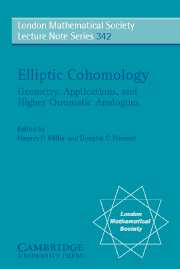Book contents
- Frontmatter
- Contents
- Preface
- Charles Thomas, 1938–2005
- 1 Discrete torsion for the supersingular orbifold sigma genus
- 2 Quaternionic elliptic objects and K3-cohomology
- 3 The M-theory 3-form and E8 gauge theory
- 4 Algebraic groups and equivariant cohomology theories
- 5 Delocalised equivariant elliptic cohomology (with an introduction by Matthew Ando and Haynes Miller)
- 6 On finite resolutions of K(n)-local spheres
- 7 Chromatic phenomena in the algebra of BP*BP-comodules
- 8 Numerical polynomials and endomorphisms of formal group laws
- 9 Thom prospectra for loopgroup representations
- 10 Rational vertex operator algebras
- 11 A possible hierarchy of Morava K-theories
- 12 The motivic Thom isomorphism
- 13 Toward higher chromatic analogs of elliptic cohomology
- 14 What is an elliptic object?
- 15 Spin cobordism, contact structure and the cohomology of p-groups
- 16 Brave New Algebraic Geometry and global derived moduli spaces of ring spectra
- 17 The elliptic genus of a singular variety
15 - Spin cobordism, contact structure and the cohomology of p-groups
Published online by Cambridge University Press: 03 May 2010
- Frontmatter
- Contents
- Preface
- Charles Thomas, 1938–2005
- 1 Discrete torsion for the supersingular orbifold sigma genus
- 2 Quaternionic elliptic objects and K3-cohomology
- 3 The M-theory 3-form and E8 gauge theory
- 4 Algebraic groups and equivariant cohomology theories
- 5 Delocalised equivariant elliptic cohomology (with an introduction by Matthew Ando and Haynes Miller)
- 6 On finite resolutions of K(n)-local spheres
- 7 Chromatic phenomena in the algebra of BP*BP-comodules
- 8 Numerical polynomials and endomorphisms of formal group laws
- 9 Thom prospectra for loopgroup representations
- 10 Rational vertex operator algebras
- 11 A possible hierarchy of Morava K-theories
- 12 The motivic Thom isomorphism
- 13 Toward higher chromatic analogs of elliptic cohomology
- 14 What is an elliptic object?
- 15 Spin cobordism, contact structure and the cohomology of p-groups
- 16 Brave New Algebraic Geometry and global derived moduli spaces of ring spectra
- 17 The elliptic genus of a singular variety
Summary
Among the interesting mathematical developments of the last twenty years has been the use of the topological technique of surgery in differential geometry. This has led, for example, to the establishment of necessary and sufficient conditions for the existence of a metric of positive scalar curvature on a simply-connected manifold, and to the construction of contact forms on certain classes of manifold satisfying the necessary tangential condition. There are also a few scattered results for metrics of positive Ricci curvature, together with an outline argument (due to S. Stolz) that a necessary condition for the existence of such a metric on a simply-connected spin manifold is the vanishing of the Witten genus. In part Stolz’ argument consists in transferring a problem about Ricci curvature on M to one of scalar curvature on the loop space LM, whose ‘K-Theory’ is elliptic cohomology. For a survey of what is known, and additional references, see.
The aim of the present paper is to formulate a programme for extending these results for simply-connected manifolds to manifolds having finite fundamental group. Leaving aside a few special cases this has already achieved for groups with periodic cohomology (p-rank = 1), and there is evidence that similar results hold when the p-rank of G = π?1M equals 2. For such groups the even-dimensional cohomology subring Heven(G, ℤ) is generated by ‘transfered Euler classes’, and many of them satisfy the stronger condition Ch(G) = Heven(G, ℤ).
- Type
- Chapter
- Information
- Elliptic CohomologyGeometry, Applications, and Higher Chromatic Analogues, pp. 318 - 324Publisher: Cambridge University PressPrint publication year: 2007



